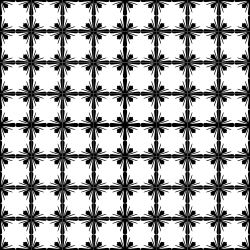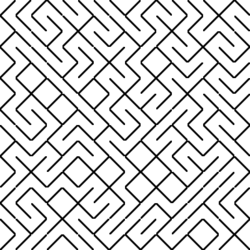Truchet tiles
In information visualization and graphic design, Truchet tiles are square tiles decorated with patterns that are not rotationally symmetric. When placed within a square tiling of the plane, they can form varied patterns, and the orientation of each tile can be used to visualize information associated with the tile's position within the tiling.[1]
Truchet tiles were first described in a 1704 memoir by Sébastien Truchet entitled "Memoir sur les Combinaisons", and were popularized in 1987 by Cyril Stanley Smith.[1][2]
Variations
Contrasting triangles
The tiles originally studied by Truchet use a pattern in which each tile is split into two triangles of contrasting colors. Each such tile has four possible orientations.

Some examples of surface filling made tiling such a pattern.
With a scheme:

With random placement:

Quarter-circles
A second common form of the Truchet tiles, due to Smith (1987), decorates each tile with two quarter-circles connecting the midpoints of adjacent sides. Each such tile has two possible orientations.


We have such a tiling:

This type of tile has also been used in abstract strategy games Trax and the Black Path Game, prior to Smith's work.[1]
Fournier pattern
Fournier resumed Truchet's work and proposed alternative patterns:
With Fournier pattern we obtain:

Diagonal
As a curiosity, a simple maze can be generated by tiles in the form of a white square with a black diagonal. As with the quarter-circle tiles, each such tile has two orientations.

See also
| Wikimedia Commons has media related to Truchet tiles. |
- Girih tiles
- Wallpaper group
- Wang tiles
References
- ↑ 1.0 1.1 1.2 Browne, Cameron (2008), "Truchet curves and surfaces", Computers & Graphics 32 (2): 268–281, doi:10.1016/j.cag.2007.10.001.
- ↑ Smith, Cyril Stanley (1987), "The tiling patterns of Sebastian Truchet and the topology of structural hierarchy", Leonardo 20 (4): 373–385, doi:10.2307/1578535. With a translation of Truchet's text by Pauline Boucher.
External links
- Weisstein, Eric W., "Truchet Tiling", MathWorld.
- Truchet in 2D and 3D: http://local.wasp.uwa.edu.au/~pbourke/texture_colour/periodic/
- Javascript animation: http://perso.orange.fr/jean-paul.davalan/divers/truchet/truc.html